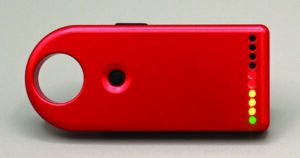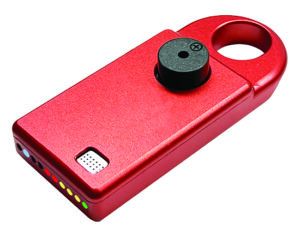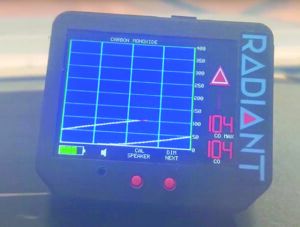Firm believers in the value of cockpit CO detectors, we’re always scanning the market for new ones to try. Since our smart CO detector roundup in the February 2023 Aviation Consumer, we found two more models from Kansas-based Radiant Technology—formerly Belite Electronics, which was part of a larger company that made ultralights.
And with a focus on compact gear for ultralight, light sport and experimental aircraft, the company offers two compact CO detectors that have smart features and a fair price.
CO PRO
The CO Pro is unique with a high- contrast digital display, including a trend graph, plus the usual aural alarm. Powered by a 700 mAh internal lithium battery, the smart CO detector is housed in a solid aluminum case and hangs practically anywhere using the carabiner opening.
The battery life is around five hours with the display at full brightness and 10-plus hours when set to Dim mode. Charge it up with a standard USB cable, which is included, but a charging point isn’t. Most users should have one that works—power banks, smart-device chargers or even the USB port on a computer. Charging takes about two hours.
At 2.1 ounces, it’s small and portable, measuring 1.2 by 2.0 by 0.4 inches. The digital display is 2.5 inches (diagonal). The CO sensor’s life should be five years or more and does not require any recalibrating.
WHAT IT SHOWS
In use, the display shows the current CO and peak CO (ppm). As the CO begins to build, an upward- facing arrow will be displayed, turning yellow at 50 to 100 ppm. At 50 ppm, the aural alarm will sound. Once the CO level exceeds 100 ppm, the arrow and numeric value turn from yellow to red. You can stifle the aural warning by pressing a dedicated alert disable button.
The display shows the current CO and peak on an interesting graph for trend. The device also includes a G-meter (+/- 6 G’s), which when selected shows a G dial and displays the current, maximum and minimum G’s (displayed above the CO readings). When the CO begins to rise, the G-meter page will automatically revert back to the CO page.
At press time, the device was listed at a sale price of $199, and the regular price was shown at $229. There’s an optional panel mount holster for securing the portable device to the instrument panel or a suitable interior surface.
GEIGER PLUS MODEL

The Geiger Plus is a small, key fob-sized CO detector that is not only inexpensive, but we think it’s practical in small cabins. Weighing in at one ounce, the little sensor can be attached to a key chain, flight bag or anywhere else you want to secure it using your own supplied lanyard or carabiner hook.
The lithium battery should power the device for about six hours when fully charged, which only takes 45 minutes to top off with a USB cable. When the device is powered off, the battery will last for up to 12 months. The kit ships with the detector and user guide. Radiant said it will ship a micro- USB cable to domestic U.S. customers who need one.

The Geiger Plus feature set is simple. There’s a single button for On/Off and LEDs positioned along the bottom of the device (the aluminum has holes, which the printed circuit board-mounted LEDs illuminate through). When you power the device on, a self-check is initiated, with the aural alarm activated and all LEDs flashing. If all is good, the first LED will remain green.
Geiger Plus uses a MICS-5524 from SensorTech, which markets the sensor as a “general purpose CO/combustible gas/VOC sensor.” SensorTech does not specify a lifetime for the sensor. They do advise that the internal heating resistor will age with usage and the detection membrane will deteriorate in relation to the presence of air pollutants, which includes the target gases. The sensor can be destroyed by overloaded gases. Geiger Plus, by design, is cross-sensitive to gasoline and alcohol and to certain compounds containing hydrogen, such as natural gas. If your cockpit has alcohol or gasoline or other VOC contamination (aftershave, as an example), you should resolve the contamination before flying with the device. While the Geiger Plus does not include a lanyard, Radiant is working on a useful on-panel adapter for the device.

LIGHTS AND TESTS
The Geiger Plus uses the LEDs to show the amount of CO in the air. LED number one will remain green when the device is powered on and sensing up to 20 ppm of CO. The next three LEDs are yellow and turn on from 21 to 25, 26 to 30 and 31 to 40 ppm of CO (respectively). LEDs five to eight are red and light up when sensing from 41 to 50, 51 to 86, 87 to 112 and more than 112 ppm.
LED number nine is blue and illuminates when VOCs are present. LED number 10 is green and blinks while the heater is warming up. The aural alarm will sound at approximately 41 ppm and higher. The pattern of the alarm will become more insistent at 100 ppm. The alarm cannot be muted, but the device can always be turned off by pressing the power switch.
Radiant recommends testing its CO products using a few matches to generate CO. In their “test lab,” they set up a simple fixture to test these CO detectors—which is essentially a fire-resistant pad, foam insulation strips around the perimeter and a glass dish. The glass dish is placed on top of the pad, enclosing the CO detector in a somewhat airtight container. With four wood matches placed inside the enclosure, CO is generated, which will cause the CO detector to begin reading CO. The CO Pro’s digital display will show CO increasing followed by the aural alarm going off. Crude, maybe, but an easy and inexpensive way to test any portable battery-operated CO detector.
The company says it cannot guarantee the absolute accuracy of the CO detectors, but they calibrate the sensors to a zero point at the factory. The quality assurance team tests each device against a lab reference point of 100 ppm. Radiant offers a recalibration service ($70), which includes replacing the lithium battery, and recommends recalibrating every year. You may reset the zero calibration point of the unit yourself. In clear calm outdoor air, turn the unit on and wait more than 60 seconds, but less than three minutes. Then press the button down continuously for five seconds. Release the button and for the next 90 seconds, the LEDs will flash. Thereafter, the new zero point is overwritten into the calibration table of the device.
FIVE-YEAR PLAN
Radiant CO devices have a one-year warranty from the date of purchase. There is an additional charge for international warranty service. Radiant offers a refund within 14 days of purchase (some conditions apply). After five years, the life of the sensor may be exceeded. We would expect that the lithium battery might be underperforming, so replacing the entire device with a new one makes a lot of sense, anyway. Based upon the cost and the changes in technology, Radiant does have a program to replace the sensor. James Wiebe, founder of Radiant Technology, makes a good point: “Better, more cost-effective tech will be available before then, which will make this product obsolete. It’s just the way things go in technology.”
BETTER THAN NOTHING
Many pilots still rely on inexpensive ($4 or so) plastic carbon monoxide (CO) detectors, which use a chemical reaction to change an orange dot to black or brown, which will return to its normal color after it’s exposed to fresh air. These plates have been the mainstay for CO detection going back to the 1990s.
But that was then, and now there is far better tech that obviously costs more. But when you think about it, aviation-grade CO monitors might costs less than one hour of flying time and with any luck, can help you avoid bad outcomes Contact www.radiantinstruments.com.


